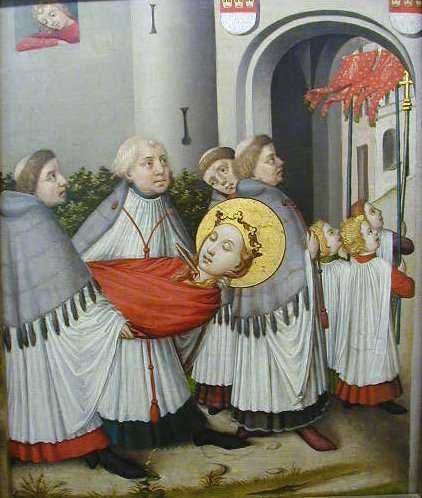return to Home Page
or move on to Goddess Theia, next chronologically,
or use Her Cyclopedia Index
Ursel, She-Bear.
6S]L
[to Whom the ninth day of July, day 190, is dedicated]

Geography/Culture: Saxon. She had a shrine at Cologne.
Linguistic Note: Latin ursa, 'a she-bear'. Allied to Greek ursa, 'a she-bear'. Allied to Greek alpha-rho-kappa-tau-omicron-sigma, (arktos), alpha-rho-kappa-tau-iota-kappa-omicron-sigma, (arktikos), 'near the bear, northern'. Celtic arto, Irish art, Welsh arth, Sanskrit rksha-s, 'a bear'. Related English words: Arthur (the name), Arctic, ursine (of, or belonging to a bear).
Description: Goddess of the moon; {Mother of the stars}; Teacher of fearlessness and the martial arts.
To Whom Sacred: she-bear; the constellations Mistress Ursula (ie Ursa-major); {Ursa-minor; the direction north}; the Berserkers, 'wearers of the bear-skin shirt' (Nordic warriors who were dedicated to Her and from Whom they acquired the bear's fighting spirit).
Festivals: September 21 -- a moon festival {perhaps in mistake for 'an equinox festival) originally in honour of Ursel, was adopted as Saint Ursula's feast date.
- Cognate with, and perhaps identical to Artio, below.
- Perhaps cognate with Erce, below.
- Teutonic Language variant: Horsel, below.
- Compare with Greek Callisto.
- Language variant: Orsel.
- Icons of Sulis, showing Her in a hat made of a bear's head, have been found, seeming reminiscent of Ursel.
- She was Christianised as Saint-Ursula, below.
- Variant Ursula.
Source: Monaghan BGH 28, 295; Walker WEMS 59, 95, 414, 1030.
Artio, She-bear.
*TYO
Geography/Culture: Celtic: Gaul, Britain, Helvetii tribes in the neighbourhood of Berne (see iconography below).
Linguistic Note: See Ursel linguistic notes.
Description: Great Goddess of wild life; Mother of animals.
To Whom Sacred: she-bear (in which She is manifest); basket of fruit; patera.
Iconography: a small bronze from Berne (now in the Berne Museum) shows Her seated near a tree offering a large bear fruit from a patera; beside Her stands a basket of fruit on a low pillar.
- Her name may cognate with Artemis, High-Source-of-Water, though not too likely if translations of the meanings are correct.
- Frequently fore-titled Dea, qv glossary.
- Cognate with, and perhaps identical with Ursel, above.
Source: Monaghan BGH 28; New Larousse EM 226; Walker WEMS 1030.
Erce, {Earth}.
=RKA
Geography/Culture: Anglo Saxon.
Description: She may have been associated with a ritual marriage rite for restoring fertility to the land.
See also Goddess Anthology under Erce.
Festival: perhaps in Solmonath (the second month of the Anglo Saxon year, approximately February at ploughing time) -- when palm-of-the-hand sized loaves, baked of every kind of meal, kneaded with milk and holy water {recipe evidently modified since introduction of Christianity}, were placed in the first furrow to restore fertility to the land.
Male associate: lover, Thomas Rhymer. Perhaps originally Her consort was the old Sky Father Tiu, ----.
- Variant: Ercel.
- See also Sol, ----, eponym of Solmonath.
- See also Thesmophoros, ----, for a similar offering of food to the earth.
- Perhaps cognate with Saxon Ursel, above.
Sources: Branston LGE 77; Monaghan 96; Walker WEMS 414.
Horsel, She-Bear.
H4SUL
Geography/Culture:
Teutonic.
Description:
Goddess of the moon and love; Eponym of Horselberg (Venusberg).
To whom are sacred: three great fires in the air (a form in which She has manifested Herself).
Male associate: lover, Tannhauser, ----.
- Compare with Hulda, (qv), Who is also associated with Horselberg.
Source: Walker WEMS 414.
Saint-Ursula.
Description:Possibly a Slavic saint.
To whom are sacred: the number 11,000 (the number of Her virgin hand-maidens, probably originally signifying the stars); the Ursulines (an order of teaching nuns).
Festival: September 21 -- originally Ursel's moon festival.
- Christianised form of Ursel, above.
printed July 1990 -- worked on July 1990; July 1991; June, July 1995.
Return to the top of this document.

